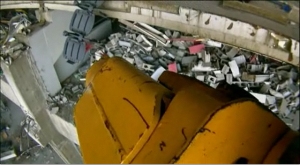Our editor, Brian Mann, has found a way to burn up to 20 minutes of 3D HD footage that will play in a Blu-ray player … without a Blu-ray recorder.
He discovered the work-around after I asked him to compile some test material we’ve shot/composited so I can show it to the broadcasters we’re delivering our first 3D documentary to.
Here’s how:
1) Put a standard-issue DVD into burner.
2) In Final Cut Pro, choose File, then Share.
3) Choose Blue-ray, then Export.
4) Wait for it to finish, and voila. The DVD thinks it’s a Blu Ray disk.
I plan to show the DVD (a montage of 3D footage and 3D VFX) during a meeting with broadcasters so they can see the visual style we’re developing.
Playing the file off of a laptop’s the alternative, but could prove problematic for several reasons:
1)Laptop would have to be powerful enough to play the files.
2)The file could crash or not play back properly.
3)Cumbersome extras – like a DVI to HDMI cable – would be required.
With a DVD, we can set up a JVC 3D HD monitor and a Blu-ray player, then play the DVD knowing it will work.
Sure, it will only burn 20 minutes – but that’s more than enough for my presentation purposes. Easy to play 3D content in a boardroom setting.
Of note: Brian’s encoding side by side so that the footage will display on the monitor properly – no dual stream. Not something we want to forget.
That, and plenty of backup copies.




